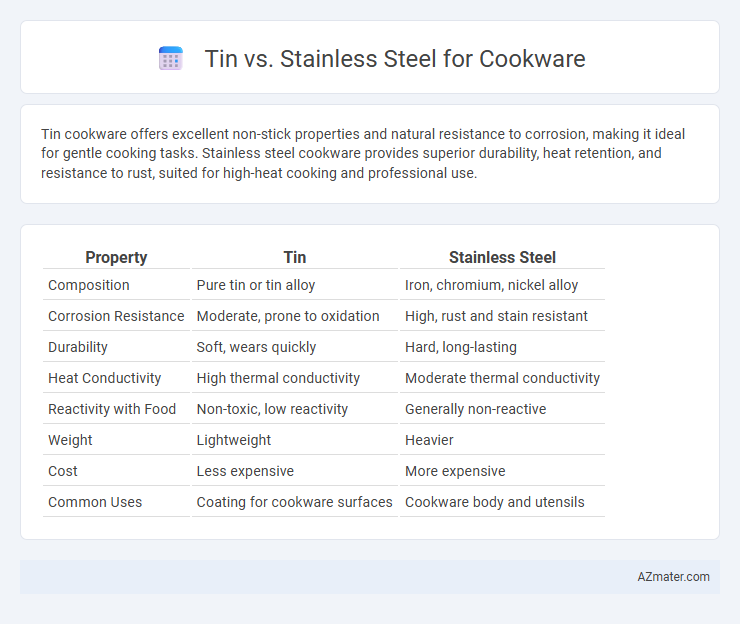Tin cookware offers excellent non-stick properties and natural resistance to corrosion, making it ideal for gentle cooking tasks. Stainless steel cookware provides superior durability, heat retention, and resistance to rust, suited for high-heat cooking and professional use.
Table of Comparison
| Property | Tin | Stainless Steel |
|---|---|---|
| Composition | Pure tin or tin alloy | Iron, chromium, nickel alloy |
| Corrosion Resistance | Moderate, prone to oxidation | High, rust and stain resistant |
| Durability | Soft, wears quickly | Hard, long-lasting |
| Heat Conductivity | High thermal conductivity | Moderate thermal conductivity |
| Reactivity with Food | Non-toxic, low reactivity | Generally non-reactive |
| Weight | Lightweight | Heavier |
| Cost | Less expensive | More expensive |
| Common Uses | Coating for cookware surfaces | Cookware body and utensils |
Introduction to Tin and Stainless Steel Cookware
Tin cookware offers excellent non-stick properties and natural resistance to corrosion, making it ideal for delicate cooking tasks and preserving food flavor. Stainless steel cookware is highly durable, resistant to rust and staining, and provides even heat distribution, suitable for a wide range of cooking methods. Both materials have distinct advantages, with tin being favored for its traditional, reactive qualities and stainless steel valued for longevity and versatility.
Material Composition: Tin vs Stainless Steel
Tin cookware consists primarily of a thin layer of tin coating over a base metal like copper, offering excellent heat conductivity and a natural non-stick surface but is prone to wear and requires careful maintenance. Stainless steel cookware is made from an alloy of iron, chromium (typically 10-20%), and nickel, providing superior durability, corrosion resistance, and a non-reactive cooking surface ideal for high-heat and acidic food preparation. The alloy composition in stainless steel ensures long-lasting performance and minimal reactivity, whereas tin coatings prioritize thermal responsiveness but demand more frequent care due to their softness and potential for coating wear.
Heat Conductivity and Distribution
Tin offers excellent heat conductivity, allowing cookware to heat up quickly and evenly, making it ideal for precise cooking tasks. Stainless steel, while less conductive, provides more even heat distribution when combined with aluminum or copper cores to prevent hot spots. The choice between tin and stainless steel hinges on balancing quick heat response with durable, even cooking surfaces.
Durability and Longevity
Stainless steel cookware offers superior durability and longevity due to its resistance to rust, corrosion, and warping under high heat, making it ideal for daily use. Tin-coated cookware is more prone to scratches and requires gentle handling to maintain its non-reactive properties, resulting in a shorter lifespan compared to stainless steel. Investing in stainless steel ensures a longer-lasting kitchen tool that withstands frequent cooking without compromising performance.
Maintenance and Cleaning Requirements
Tin cookware requires careful maintenance to prevent denting and frequent re-tinning to maintain its non-stick, anti-reactive surface, often requiring gentle hand washing with mild soap. Stainless steel cookware offers superior durability with a hard, corrosion-resistant surface that can withstand aggressive scrubbing and dishwasher cleaning without damage. Proper cleaning of stainless steel cookware involves removing food residues and discoloration using specialized stainless steel cleaners or a mixture of vinegar and baking soda to maintain its polished appearance.
Safety and Reactivity with Food
Tin cookware provides a non-reactive surface ideal for cooking acidic foods, preventing metal leaching and preserving flavor integrity. Stainless steel is highly durable and resistant to corrosion, but its reactive properties may cause slight metallic taste when cooking highly acidic or alkaline dishes. Both materials are generally safe, though tin's natural, non-toxic coating offers superior food safety by minimizing chemical interaction during cooking.
Weight and Handling in the Kitchen
Tin cookware offers lightweight ease, making it ideal for quick handling and precise maneuvering during cooking. Stainless steel, while heavier, provides superior durability and stability, especially useful for tasks requiring firm control or longer cooking durations. Selecting between tin and stainless steel cookware depends on balancing the need for lightness and maneuverability against robustness and heat resistance in kitchen performance.
Price Comparison and Affordability
Tin cookware generally offers a more budget-friendly option compared to stainless steel, making it suitable for cost-conscious buyers seeking basic functionality. Stainless steel cookware, typically priced higher due to its durability and resistance to corrosion, provides long-term investment value despite the initial expense. For affordability, tin is ideal for short-term use or specialized cooking, whereas stainless steel balances cost with longevity and versatility.
Ideal Uses for Tin and Stainless Steel Cookware
Tin cookware excels in cooking delicate foods like fish and eggs due to its non-reactive surface and excellent heat conduction. Stainless steel cookware is ideal for searing, browning, and deglazing because of its durability, resistance to corrosion, and ability to withstand high temperatures. Each material serves distinct culinary purposes, with tin best suited for gentle cooking and stainless steel preferred for versatile, high-heat applications.
Conclusion: Choosing the Right Cookware for You
Choosing between tin and stainless steel cookware depends on your cooking needs and maintenance preferences. Tin offers excellent heat conduction and non-reactive qualities, ideal for delicate dishes, but requires careful handling to avoid damage. Stainless steel provides durability, resistance to corrosion, and versatility for high-heat cooking, making it a practical choice for everyday use.

Infographic: Tin vs Stainless Steel for Cookware
 azmater.com
azmater.com